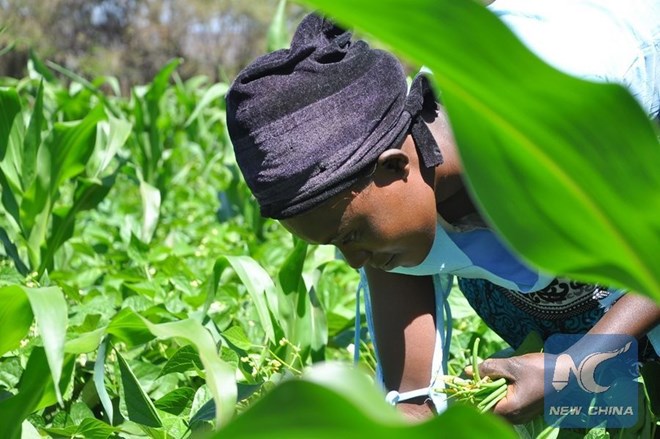
Tuesday January 17, 2017

A woman picks French beans for the export market at the Kabaa irrigation scheme in Machakos County, Kenya, Sept. 13, 2013. (Xinhua/Allan Muturi)
NAKURU, Kenya, Jan. 17 (Xinhua) -- Kenya's Samwel Kamundai has found an innovative way to buffer against hunger, malnutrition and poverty and it involves intensive crop diversification in his three acre farm.
The small-scale farmer in Kenya's Nakuru county had until 2013 been practicing monocropping that later proved risky and unsustainable in the light of climatic stresses and declining soil fertility.
He grew only maize in his farm but thanks to encouragement from extension workers, Kamundai diversified into other crops like legumes and fresh produce.
"Growing maize alone is risky since a farmer can lose an entire harvest to diseases and pests. There is need therefore to explore other crops that can act as a buffer against hunger during the dry spell," Kamundai told Xinhua during a recent interview.
His farm is currently an embodiment of multiple benefits than crop diversification can unleash to smallholders.
Kamundai has been growing vegetables, legumes, potatoes and indigenous fruits in his farm.
Likewise, he has also ventured into bee keeping and rearing of rabbits whose meat sells like hot cake in the local market.
The middle aged farmer who recently retired from public service practices drip irrigation to buffer against crop failure during the dry spell.
He disclosed that growing a variety of crops has not only guaranteed his family food security but has as well boosted his income.
"Since venturing into intercropping, am relieved from the stress of inadequate food supply and declining revenues," said Kamundai. He also practices crop rotation that adds nutrients to the soils.
On a normal day, Kamundai hosts many farmers from neighboring villages who visit his farm to learn about the benefits of crop diversification.
"It is my wish to see other farmers progress in their agricultural activities. Visiting my farm gives them a first hand experience of what it means to diversify farming and I do discourage them against monocropping or depending heavily on one single crop," Kamundai said.
"I am happy to educate other farmers on how to practice intercropping that comes with many benefits," Kamundai remarked adding that he intends to be a national champion for crop diversification.
At the same time, Kamundai urged the ministry of agriculture to deploy additional extension officers to train smallholder farmers on how to practice intercropping.
Large scale adoption of crop diversification could help tackle hunger and malnutrition affecting millions of Kenyan rural dwellers.
Kamundai and his peers have been able to produce enough staples for household consumption and sale thanks to inter-cropping.
Government statistics indicate that an estimated 2 million Kenyans are facing starvation occasioned by the current dry spell.
Experts agreed the east African nation must adopt innovative farming methods that can withstand climate vagaries to cushion the population against hunger.
Kamundai said the government ought to ensure agricultural extension officers visit farmers in the villages to educate them on proper farming practices as this would lift burdens of food insecurity, hunger and poverty from households.
"It is good to have farmers learning from each other but I believe there would be more impact if agricultural officers visited farmers in their farms regularly to educate them on what needs to be done and monitor their progress," he said.
Worrying is that the impacts of the drought are affecting areas formerly zoned as high food producers particularly in the eastern region.
The warning reinforces an alert given by Food and Agriculture Organization (FAO) in December 2016 of the expected drought that would devastate people with hunger.
But Kenya is not the only country on a hunger alert. Zimbabwe, Ethiopia and Somalia are also on list of countries to face the ravages of drought likely to influence migration of people and their animals to food and water-sufficient areas, which sometimes spark conflicts.